This was published 1 year ago
Opinion
Sydney has a date with density. I asked a gold medal architect how we get it right
Peter FitzSimons
Columnist and authorPhilip Thalis is one of the nation’s leading architects and urban designers, with comprehensive knowledge of Sydney’s architectural history. He has just been awarded the Australian Institute of Architects’ Gold Medal for 2024. I spoke with him on Thursday.
Fitz: Congratulations on your honour, Philip, essentially a lifetime achievement award in your chosen profession. When did you conceive the passion to be an architect?
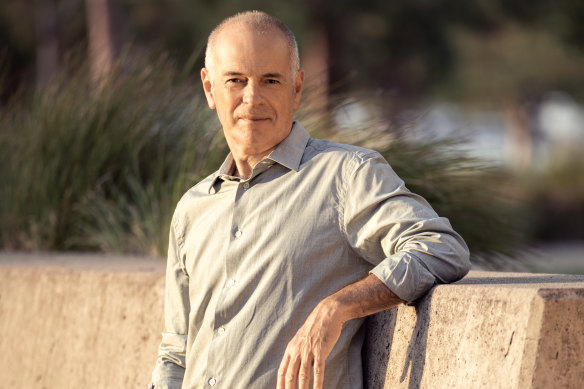
Philip Thalis, recepient of the 2024 Gold Medal of the Australian Institute of Architects.Credit: Nic Walker
PT: I grew up in a red-brick, three storey, walk-up block of flats in Maroubra, three boys in 100 square metres, surrounded by similar flats and, as a 10-year-old, I would walk around and think “We must be able to do something better than this”. And as we had Airfix blocks at home – a precursor to Lego – I used to make streets lined with buildings on the floor with my brother. Much later I graduated from Sydney Uni in Architecture by the mid-80s – focusing on public space, city-making and how architecture contributes to it with urban housing, rather than the more typical pathway of private houses – and went from there.
Fitz: What was your first gig?
PT: I was poached with several other graduates by Sydney Uni’s Dean of Architecture to work on what was then the new Darling Harbour scheme. But we all left within six months because we thought it was dire.
Fitz: Do you still think that?
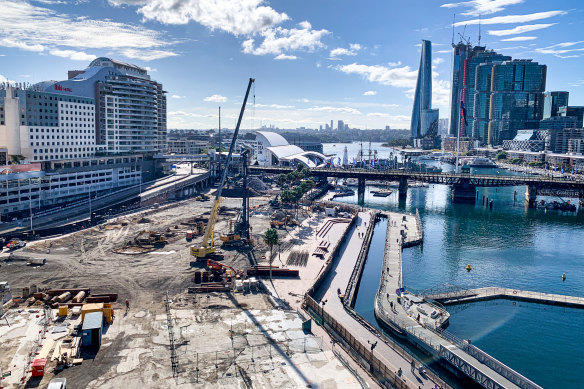
“Darling Harbour was a failure then, and it hasn’t gotten any better.”Credit: Peter Rae
PT: Yes, I think Darling Harbour was a failure then, now wantonly demolished just 30 years later. Still so lacking integration with the broader city, it is a place apart that turns everyone into a tourist in their own city. There’s no everyday amenity as they excluded housing, with nowhere to even buy a carton of milk – it was intentionally conceived of as something of a funfair. I left after having to assess transport there – they chose the Monorail, which was always a flawed gimmick – and we started “Sydney Citizens Against the Monorail”. We lost the battle but won the war because it was clearly always going to fail.
Fitz: Why?
PT: Because it was simply not a viable urban transport system. It could never carry enough people, just a lazy loop rather than being the beginning of an essential transport system tied into the territory of the city. Research showed that globally such small loops belonged in amusement parks, so it could never be real public transport.
Fitz: But now, the breakthrough. You and your nascent firm, Hill Thalis Architecture + Urban Projects, jointly win the nationwide competition in 1992 to design the Sydney Olympic Village, with a green-theme that helped us beat Beijing bid by a single vote. But this is the part I don’t understand. I see that despite winning that competition, and despite also winning the 2006 Barangaroo design competition, neither actually got built. How can that be?
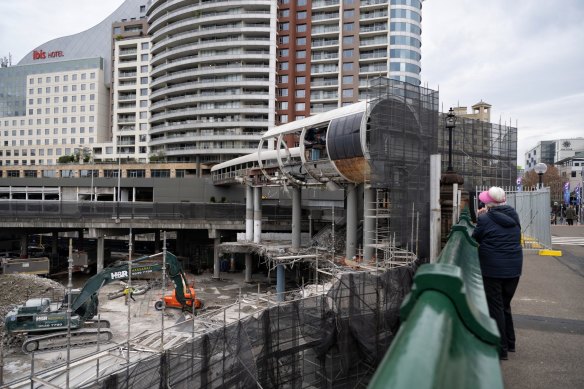
The former Harbourside Shopping Centre and Monorail station being demolished in Darling Harbour in June 2023.Credit: Nick Moir
PT: [Slightly snarling laugh.] Because this is NSW, Peter, and “A” doesn’t necessarily lead to “B”. While Europe’s got a very strong culture of architectural and urban competitions, Australia – and Sydney in particular – just doesn’t. We were, in both cases, “NSW-ed” and what ended up being built was the antithesis of what won us each of these competitions. What was built was what we were trying to prevent.
Fitz: “NSW-ed” as a verb?
PT: Sorry, yes. People casually say it goes back to the Rum Rebellion. In fact, it goes back to the moment when Governor Phillip boarded the boat to return to England in 1792 and his officers thought, “You beauty, we can divvy up the land amongst ourselves”, which they started doing immediately. And, you know, calling it the Rum Rebellion was only partially right. We call it the “land rebellion”, because Governor Bligh had written back to England seeking instructions on all these illegal land grants and buildings constructed in Sydney Town – “What do I do about them?” But he was deposed by the land barons before any reply came back.
Fitz: Yes, but in the modern age, what does being “NSW-ed” mean?
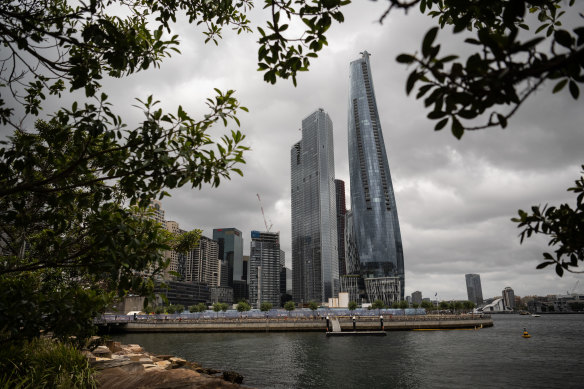
“What were they thinking?” The Crown tower at Barangaroo.Credit: Wolter Peeters
PT: [Carefully. Choosing his words.] Let’s say that too often it seems that powerful interests hold sway over proper procedure and the public interest.
Fitz: After winning the Barangaroo competition, Paul Keating famously had a big go at you, saying that in your plans you were [too focused on heritage] and trying to “preserve industrial vandalism”, or something like that.
PT: Yes, whatever he said, you don’t have to quote Keating, he gets enough bloody press. Look, Keating is one of the villains of Barangaroo, no question, he spotted the vacuum of urban understanding from successive NSW governments. But I have to be careful what I say...
Fitz: Yes, but need I remind you: You are now the gold medallist, the acclaimed architect and urban planner of our time. You have the floor, on top of the podium, so say your piece!
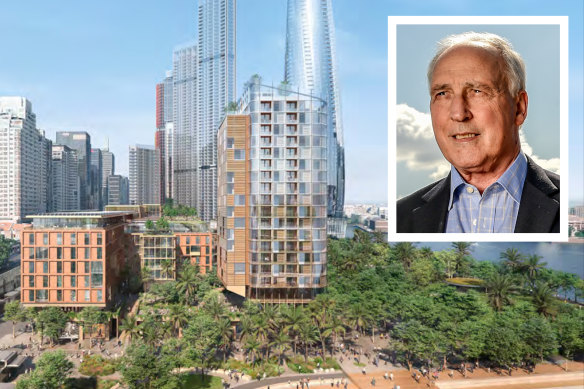
Barangaroo today “stands as a site of exploitation” and Paul Keating (inset) “is one of the villains”, Thalis says.Credit: Brendan Esposito
PT: Well, the things that Keating has volubly criticised about our Barangaroo design are neither fair nor accurate. Go see our hugely popular Pirrama Park in Pyrmont project at the end of Harris St by the harbour, done contemporaneously for the City of Sydney. Remember, Barangaroo is public land, yet today it stands as an enclave of exploitation, the triumph of private greed over public benefit. It stands as a punitive lesson, one that we must never repeat. Keating has been prime minister, and as you know, he did many great things, including the Redfern speech which remains an unsurpassed statement of record and reconciliation. But on urban issues, history won’t be so kind.
Fitz: Let it out, Philip.
PT: We’ve been failed by all tiers of government, especially the absent Feds, and for too long a time. A book published a few decades back titled Accidental Sydney chronicled the city’s many architectural and urban miss-steps. But the title is just not true. Every decision has been conscious, don’t excuse them as being mere accidents. They are mistakes, many miscellaneous but some so grave that they reverberate down the centuries, almost impossible to reverse. We need to study more enlightened cities, with a deeper, longer understanding of the enduring values of good city making
Fitz: The citation for your gold medal, says that, “As Australia learns to lean in to the density dictated by the current housing affordability and climate crisis, and we become more reliant on public spaces as community living rooms, there is much to be learnt from Thalis’s approach.” Tell us about the importance of integrating private and public space?
PT: In lectures, I say public space is actually the physical manifestation of democratic society. So when people talk about privatising it, the reason you don’t do it is because it is in the public spaces we come together as a society, and it enshrines our values – including our right to dissent. Wherever you want to demonstrate against something that governments do, you do it in public space, where our rights as equal. In all my work I’m really trying to uphold the French philosopher Henri Lefebvre, who talked about “the right to the city”. And that’s absolutely my foundational position.
Fitz: Ok. Do Henri proud. What do we need to do in Sydney, now, as we try and fit another million people or so in the next few years?
PT: We don’t need a mega-city, and we need to keep a connection to the environment at all scales. So we shouldn’t be subdividing more blocks on the edge of Sydney. Chris Minns had a very good line when he came in as premier, saying “We don’t need to build a new street every week on the edge of Sydney.” He is dead right.
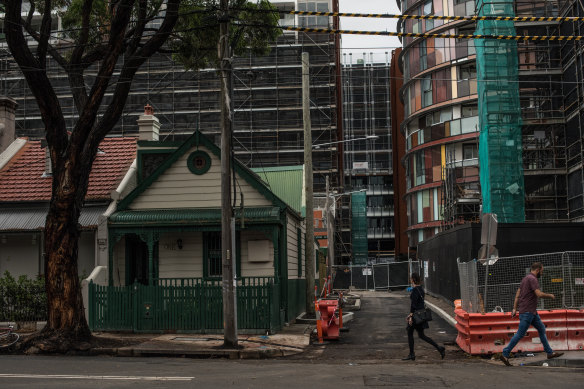
Every decision to build ugly and uninspiring developments in Sydney “has been conscious, not accidental”.Credit: Wolter Peeters
Fitz: How, then?
PT: We need to use land much more responsibly. We need to build a denser city, without necessarily relying on clusters of towers. We need to build a gentler sort of “green urbanism”. That’s what I’ve always been working towards.
Fitz: Please define.
PT: Well, we need mid-rise buildings four to six storeys that are no taller than the trees. People living in walkable green streets, with public parks and transport nearby.
Fitz: And for land, do you claim back some of the golf courses, as has been mooted?
PT: Absolutely, I am all on board with claiming back the south half of Moore Park Golf Course. Back in 1810, Governor Macquarie far-sightedly reserved this land as part of a great “common”, available to all, yet now 45 hectares are fenced off, only open to a few people at a time. That is not right, that land is now needed for the broader public.
Fitz: What about racecourses? Does this city need all of Randwick, Canterbury, Warwick Farm and Rosehill – the last of which is likely to be put to 25,000 homes?
PT: Certainly such land could be reclaimed for parks and housing. The technical term is that the crown land has been “alienated” – that is, free public access has been denied. Racecourses and golf courses that are built on public land have been alienated and we should be reopening them. In a similar vein, Peter, public schools shouldn’t be ringed by 1.8 metre fences and have their gates closed on weekends. Our city isn’t full, and we should be using public land a lot more intelligently.
Fitz: That will indeed give more land for the people in public. But what of their places to go home to, re the housing crisis?
PT: I’m a great supporter of better urban housing, particularly public and affordable housing. The aim of city-making, the point of planning is that you can redress imbalances through public policy. And in a country as rich as ours, the availability of land and decent housing shouldn’t be left to unfairness and exploitation. When I worked in Paris, all the best housing was being built by public authorities not developers – theirs was so lacklustre. There, 30 years ago, something like 13 to 16 per cent of residences built were public housing. Their target is now 25 per cent. In London, they’ve got targets of between 25 and 40 per cent affordable housing in redevelopment areas.
Fitz: What is the percentage here?
PT: That’s been announced in recent weeks by the NSW government – and it is 2 per cent! As our public housing stock has dwindled, it’s become welfare housing, rather than serving a broader spectrum of society – as in affordable housing for teachers, firemen, nurses, who are being priced out. Australia has gone missing in this space for 30 years, and we so need a renaissance in the construction of high-quality public and affordable housing. There’s an obligation, and a huge opportunity for all tiers of government, because right now we’re in a deep crisis with a waiting list in NSW of 60,000 plus for such accommodation.
Fitz: What do you think of the state government’s housing policy, as it stands, to build around the transport hubs? Is this possible to do while maintaining quality architecture both aesthetically and structurally?
PT: Yes, certainly it’s possible but not enough. To me, we shouldn’t have hyper-density around rail as the sole criteria for where we concentrate density. Let’s match the higher densities to where there’s the highest amenity, in places people want to live – proven to be within about 10 kilometres of our city’s centres, on many park frontages, on quieter green streets, nearer our many waterfronts. They’re all fantastic places to share in increased density, particularly when they overlap with good transport.
Fitz: And is good public transport the other key to having Sydneysiders fit together happily, and unlocking higher density living?
PT: Yes. We should give the recent Liberal state government some credit for at least getting on and building some. But we need to continue, and accelerate the public transport renaissance of Sydney. We used to be a great public transport city. But we let that slip in the post-war period, and must get it back.
Fitz: What are the upcoming pain points you see, in terms of protecting heritage buildings in Sydney, while also managing a growing population? Is there an area or structure you think is at risk of being lost?
PT: I think we can readily do everything well – that’s very much where we as architects do our best work! I’ve reviewed thousands of schemes on design review panels or when I was a City of Sydney councillor, and I’d say to developers and architects: “If you’re not willing to live in that apartment, or that bedroom; if you wouldn’t want members of your family living there, then fix the design.” Surely that’s an ethical and environmental imperative, too often missed in today’s planning quagmire.
Fitz: What building do you look at in Sydney, and shout, “Oh, my God, what were they thinking?”
PT: The casino at Barangaroo.
Fitz: Thank you. It feels like Sydney has a lot of homework to do.
The Opinion newsletter is a weekly wrap of views that will challenge, champion and inform your own. Sign up here.